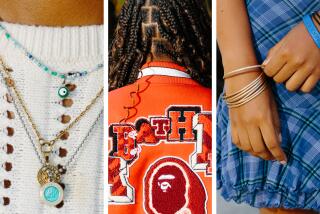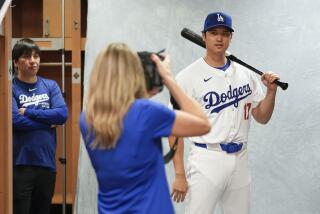FASHION : Formal Uniforms Have Worn Out Their Welcome : Now workers tend to wear what’s comfortable--jeans and sneakers. Mild weather makes shorts a hit with many.
- Share via
In case you’re wondering, the “Repairman” who saves the day for the laundry lorn in Maytag TV commercials is not a real-life super-hero. His eight-point military cap and bow tie give him away. The guy’s a phantom from the ‘50s.
A service person arriving at your door today is as likely to wear that cap and tie as he (or she) is to call you by your last name. Fast-food franchises aside, uniform fashions have gone informal.
If you don’t think so, look at nuns. Or hair stylists, who have disdained their smocks. Or nurses. Once distinguished by the symbolic white cap, nurses now whisk bareheaded down hospital halls.
“I have been asked many times, ‘Are you the real nurse?’ ” said Susan Maccioli, an R.N. at Community Memorial Hospital in Ventura.
“Caps just went by the wayside. The patients like seeing it--but they just weren’t practical.”
White dresses are nearly as extinct. In Maccioli’s department, intensive care, nurses wear teal scrub suits with teal, green and pink lab coats.
“I always say, ‘Put three of us together, we look like a shower curtain,’ ” she said.
Or, as a former nurse recently told us, “You can’t tell a nurse from a cleaning lady.”
Worse, potentially: You can’t always tell a delivery person from a bandit.
Suppose you receive a Western Union telegram or money order. There was a time when it would be brought by a young man with buzzed hair, a military cap, coat and knickers with piping, and shined boots.
Overkill, you say. But now in Ventura County, the messenger, from a company called Go-Between, is an authorized agent of Western Union; and the drivers wear jeans and sneakers. (Unless you order a local singing telegram. But, that’s another story.)
Most services still retain some formality. Federal Express drivers wear dark polo shirts and shorts; you know they’re in uniform if you look closely. Postal carriers, once decked out in full uniform, hat and badge, now make their appointed rounds in optional shorts. On their heads are optional baseball caps, pith helmets--which some like for the rain--or nothing.
Santa Paula Postmaster Howard Rivera said the county also has about 20 rural carriers who deliver outside the city limits and wear whatever they please--as long it’s not short shorts.
In Ventura County’s climate, shorts are a hit with drivers. Our neighborhood Chase Brothers Dairy routeman wears them most of the year--but he’s an independent contractor. If the company’s wholesale supervisor, Frank Redburn, had his way, the drivers would look a bit more professional.
With uniforms, Redburn said, “You get the impression that things are going to be uniform. It’s an illusion, but you have peace of mind.”
When Redburn started delivering milk 18 years ago, the drivers all wore full white uniforms and bow ties. The white military caps had already been retired--as it happens, in 1968, the year of general cultural rebellion.
That classic cap, once a service icon, is almost gone from the uniform scene. Its use is down about 95% from a generation ago, according to Ed Sbertoli at Midway Cap Co. in Chicago.
Sbertoli custom-made the cap for Repairman’s dramatic TV scenes. In real life, he said, baseball-style caps have taken over with uniformed services. Law enforcement agencies--even our own Ventura County sheriffs--tried them for awhile. Most abandoned them again, beginning in the ‘70s.
“They found they weren’t getting the distinct look that they needed as an officer. Guys were saying, ‘Well, you had a baseball cap on--I didn’t know who the hell you were,’ ” Sbertoli said.
One figure closely associated with the eight-point cap was the cab driver. At Ventura Cab, spokesman John Datwyler said their drivers rejected the caps and uniforms in general when they became independent contractors in the early ‘80s. Personally, he thought it was a poor move.
“When they wore them, it was easier for them to find fares,” he said.
And so it goes.
But, going casual is not entirely uniform, so to speak. A bit of backlash has surfaced at Thousand Oaks Cab Co.
Cheryl Duesterhoft is buying uniforms for her staff of drivers for the first time since the company began in 1960. No caps; but men and women alike will wear white shirts, navy blue jackets, navy neckties and trousers.
“I just thought it would look nicer,” said Duesterhoft, who said she sometimes has to monitor younger drivers’ casual styles.
Apparently, the new, more formal look has not been fully accepted by some of her employees, Duesterhoft said, particularly the night drivers.
It’s the sort of concern you’d never hear expressed by Repairman.
“They’re afraid they are going to get laughed out of the bars,” she said.






